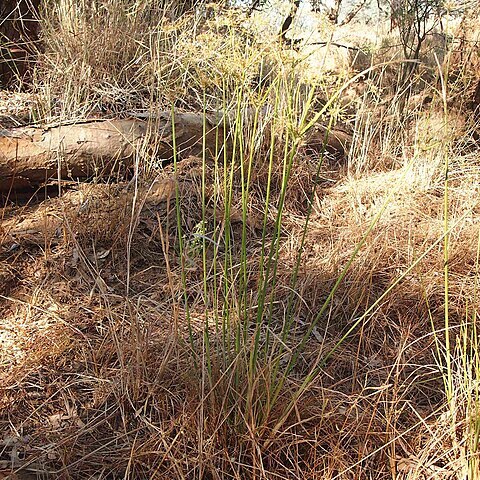Perennial with very short rhizome. Stems tall, densely tufted, trigonous, smooth, 100-180 cm by up to 8 mm. Leaves flat or plicate with the midrib prominent beneath and 2 lateral nerves strongly marked above, coriaceous, scabrous on the margins and scaberulous on the upper surface, bright green above, pale green beneath, 8-15 mm wide; lower sheaths somewhat spongy, reddish to blackish brown. Inflorescence compound or decompound, up to 25 cm long. Involucral bracts 4-6, erecto-patent, up to 80 cm long. Primary rays 6-9, slender, unequal, smooth, up to 18 cm long, secondary ones up to 5 cm. Spikes digitately arranged, usually some of them solitary on slender peduncles, cylindric, loose to rather dense (up to c. 40 spikelets to the spike), finally 2-5 by 1-1½ cm; rachis visible among the spikelets, somewhat flexuous, glabrous, narrowly winged. Spikelets spicately arranged, subdistichous, obliquely patent or almost at right angles to the rachis, oblong to linear, compressed, 10-20-flowered, 5-10 by 1½-2 mm; rachilla straight, persistent; internodes c. 2/5 mm; wings caducous, narrowly oblong, whitish or yellowish. Glumes membranous-chartaceous, patent, ovate or broadly ovate, obtuse, mucronate, 1½-2 by 1¼-1½ mm, ½ imbricate; keel green, 3-5(-7)-nerved especially above, sides nerveless or obscurely striate, shining brown or greenish. Stamens 3; anthers oblong, ½-⅔ mm long; connective shortly produced, smooth. Stigmas 3. Nut trigonous, ellipsoid, shortly apiculate, yellow or yellowish brown, ⅔-4/5 by ⅓-½ mm.
More
Perennials. Roots many, fibrous. Rhizomes short. Culms 1-1.5 m tall, stout, 3-angled, smooth, basally with leaves. Leaves nearly as long as culm; sheath purplish brown, long; leaf blade 6-10 mm wide, margin scabrous. Involucral bracts 3-6, basal ones longer than inflorescence. Inflorescence a compound or decompound anthela; rays 5-10, to 18 cm, unequal in length, each with several raylets. Spikes 1-3 at raylet apex, cylindric or narrowly cylindric, 2-5 cm × 2.5-10 mm, with many spikelets. Spikelets subdistichous, densely or laxly arranged, narrowly oblong-ovoid, 2-6 × 1-1.5 mm, compressed, obliquely spreading, 4-25-flowered; rachilla wings white, linear, narrow, hyaline. Glumes dark grayish brown to yellowish brown, slightly densely imbricate, ovate, 1.5-1.6 mm, slightly shiny, 3-5-veined, keel green, apex obtuse, mucronate, and not excurved. Stamens 3; anthers linear, ca. 1 mm; connective prominent beyond anther apex. Style slender; stigmas 3. Nutlet obovoid to ellipsoid, less than 1/2 as long as subtending glume, 3-sided, smooth. Fl. and fr. Jun-Nov.
A sedge. It keeps growing from year to year. It has short rhizomes. The stems are 1-1.5 m tall. They are stout and 3 angled. The leaves are 6-10 mm wide.
Obtuse, cylindrical, lax-spikeletted, golden, rayed spikes
Robust plant up to 1·6 m. high
Grasslands, pond margins, sandy soil, moist or wet places; at elevations from near sea level to 1,100 metres. Wet places at low elevations: embankments in tidal forests, grassy swamps behind the beach-wall.
More
In wet places at low altitudes: embankments in tidal forests, grassy swamps behind the beach-wall, in Timor in grass-flats at 400 m.
It grows throughout the tropics. It grows in wet or swampy places.


